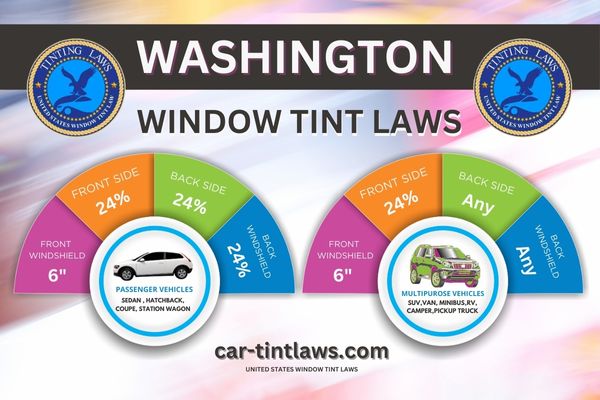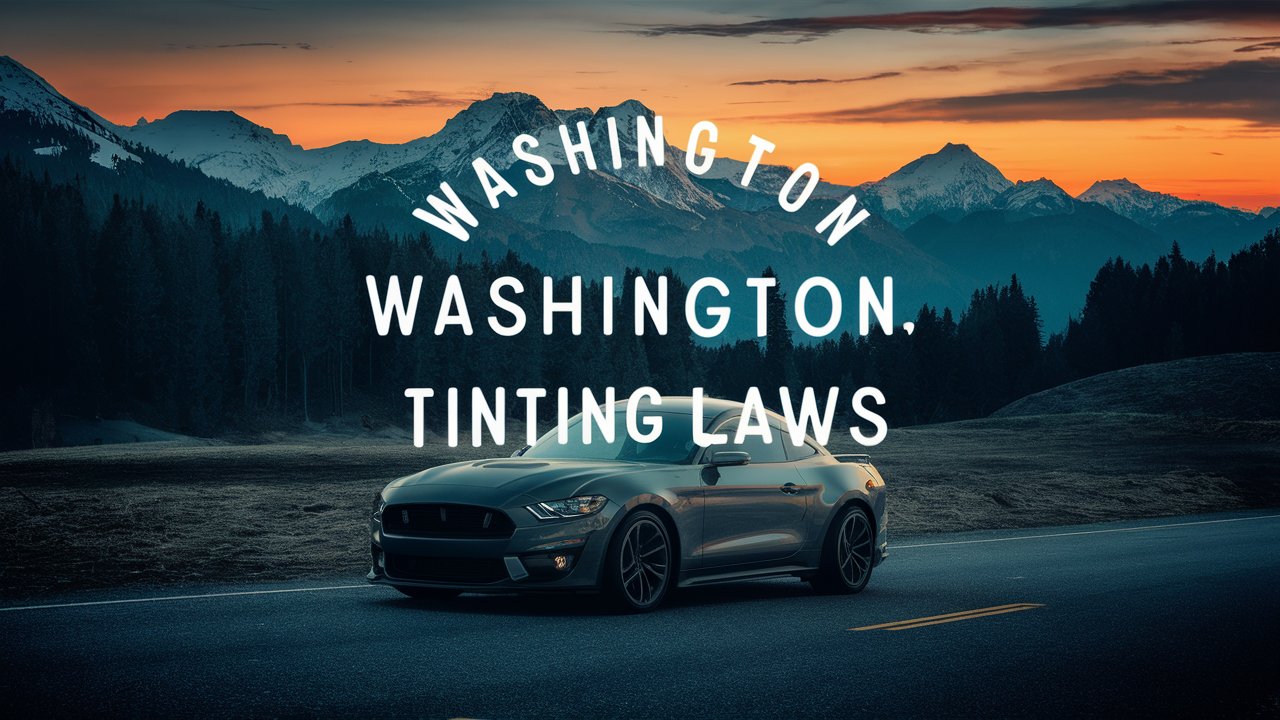Did you know that in Washington, sedans must have a minimum Visible Light Transmission (VLT) of 24% on all windows?
This regulation guarantees that enough light passes through your car windows to maintain visibility and safety.
But what happens if you don’t follow these rules? With fines reaching up to $136 per offense, non-compliance can get costly.
Plus, there are different requirements for SUVs and vans, including limits on reflectivity and prohibitions on mirrored films.
Understanding these distinctions can save you both time and money—so what’s the best way to stay compliant?
Window Tint Darkness in Washington
When it comes to window tint darkness in Washington, you’ll find different regulations for sedans compared to SUVs and vans.
For sedans, the front side windows must allow more light through than the rear windows.
SUVs and vans have more flexibility, especially for the rear windows, but all vehicles must adhere to the state’s overall VLT and reflectivity requirements.
Tint darkness for sedans:
- Windshield: Non-reflective tint is allowed on the top 6 inches of the windshield.
- Front Side windows: Must have a minimum of 24% VLT.
- Back Side windows: Must have a minimum of 24% VLT.
- Rear Window: Must have a minimum of 24% VLT.
In Washington, sedans must adhere to a minimum window tint darkness of 24% VLT for front side windows, back side windows, and rear windows.
This regulation ensures visibility and safety on the road, aligning with the state’s transportation authorities’ standards.
Remember that VLT, or Visible Light Transmission, quantifies the light passing through your windows.
Washington law mandates proper certification and identification of the window tint darkness on sedans.
All tint applications must be certified to meet state standards. Sedans can have a tint strip of any darkness on the top 6 inches of the windshield, aiding in reducing glare while maintaining driver visibility.
Tinting sedan windows offers benefits like UV protection, heat reduction, privacy, and glare reduction.
Adhering to the specified tint darkness is crucial for compliance with state regulations.
Ensure professional installation to guarantee adherence to legal requirements and obtain appropriate certification.
This approach allows you to enjoy tinted windows’ benefits without encountering legal complications.
Tint darkness for SUV and Vans:
- Windshield: Non-reflective tint is permitted on the top 6 inches of the windshield
- Front Side windows: Must allow more than 24% of light transmission
- Back Side windows: Any shade can be used
- Rear window: Any shade can be used
Window Tint Reflection in Washington
When it comes to window tint reflection in Washington, it’s important to know that the rules differ slightly for sedans and for SUVs and vans.
For sedans, the maximum allowable reflectivity is 35%, which helps to reduce glare and heat without causing safety issues.
SUVs and vans also follow the same reflectivity limit, ensuring that all vehicles maintain safe driving conditions while enjoying the benefits of reflective tinting.
Tint reflection for sedans:
- Front Side windows: Must not be more than 35% reflective.
- Back Side windows: Must not be more than 35% reflective.
Tint reflection for SUV and vans:
- Front Side windows: Must not be more than 35% reflective.
- Back Side windows: Must not be more than 35% reflective.
- Reflective Tinting: Limited to 35% for all windows on SUVs and vans.
- Mirrored Films: Prohibited for SUVs and vans to avoid significant glare.
- Safety Compliance: Washington state’s regulations aim to ensure safer driving environments.
- Glare Concerns: Excessive tint reflection can impair vision, especially during sunny days or at night with headlights on.
- Balanced Approach: Following these guidelines promotes safer driving conditions while maintaining privacy and style.
Other Washington window tint rules and regulations
- Side Mirrors: No restrictions.
- Restricted Colors: In Washington, only non-reflective tint is allowed on the front side windows, back side windows, and rear window.
- Certificates: Manufacturers of film need to certify the film they sell in the state. Ask your dealer if they are using certified film.
- Stickers: The sticker/label of compliance to identify legal tinting is required between the film & glass on each tinted window.
- Medical Exceptions: Washington allows medical exemptions for special tint. For more details about the specific terms of the exemption, consult WA state law.
- Penalties: Fines for tint violations can range from $136 to $228. It’s crucial to ensure your tint complies with state regulations to avoid penalties and maintain road safety.

Medical Exemptions for Window Tint Rules in Washington
If you have a medical condition that requires it, Washington allows you to apply for an exemption to the standard window tint rules.
The state offers medical exemptions that enable individuals with specific medical conditions to use special tint on their vehicle windows.
According to Washington’s window tinting laws, you’ll need a doctor’s note to qualify for a medical exemption.
This documentation must clearly state the medical necessity for darker tint due to your condition.
The medical exemption permits you to have a darker tint than the state laws usually allow, providing relief and comfort while driving.
However, it’s vital to mention that these exemptions aren’t permanent. You’ll need to renew your medical exemption periodically in line with state regulations, ensuring that your condition continues to warrant the special tint.
Washington’s window tint rules are designed to balance safety with personal needs, and the medical exemption is a good example of this flexibility.
If you believe you qualify for a medical exemption, consult your healthcare provider and gather the necessary documentation to submit your application.
This way, you can adhere to state laws while addressing your health requirements.
Washington Window Tint Ticket Cost
Facing a window tint violation in Washington can result in fines up to $136 per offense.
Enforcement of window tint laws in Washington State is carried out by State Troopers and local law enforcement agencies.
It’s important to understand specific regulations regarding tint darkness and reflectivity for sedans, SUVs, vans, and windshields to avoid these fines.
Washington State has detailed rules that must be followed. If you’re found in violation, you could face fines that can quickly add up.
To stay compliant, you should familiarize yourself with these regulations. However, there are provisions for those who need exceptions.
Washington allows for medical exemptions if you have a doctor’s note indicating the necessity for darker tints.
Additionally, the process for obtaining medical exemptions and special permits is essential to remaining within the law. If you qualify, make sure you go through the proper channels to get the necessary documentation.
This will protect you from potential violation fines and make sure you are legally compliant with Washington State’s window tint laws. Understanding these steps will help you avoid fines and drive with peace of mind.
Washington State Overview
Washington State’s window tinting regulations, established in 1993, set specific limits on the darkness and reflectivity of window films.
You’ll need to understand the legal tint limits, which dictate how much light must pass through your vehicle’s windows, and the enforcement mechanisms that guarantee compliance.
Knowing these rules can help you avoid penalties and maintain your vehicle within legal standards.
State Tinting Regulations
When it comes to window tinting in Washington State, you need to know that sedans must have a minimum Visible Light Transmission (VLT) of 24%, while SUVs can go as low as 20%.
This means your window tint must allow at least that percentage of light to pass through.
Additionally, the maximum allowable reflectivity for window tint in Washington is 35%, guaranteeing that your tint doesn’t create a mirrored effect that could impair visibility for other drivers.
Washington State does allow for medical exemptions if you have a legitimate medical condition that requires darker tinting. You’ll need a doctor’s note to qualify for this exemption.
It’s important to adhere to these regulations closely because violations can result in fines of up to $136 per offense.
Each vehicle type, whether a sedan, SUV, or van, has specific regulations regarding tint darkness and placement.
Understanding these rules helps you comply with state laws and avoid penalties.
Always check the latest guidelines to confirm that your vehicle’s window tint meets Washington State’s requirements.
Following these regulations not only keeps you legal but also ensures safer driving conditions for everyone.
Legal Tint Limits
Knowing the specific legal tint limits is crucial for guaranteeing your vehicle complies with Washington State’s regulations.
In Washington, the visible light transmission (VLT) for front and back side windows on sedans must be more than 24%, while SUVs are allowed a slightly lower VLT of more than 20%.
This means your window tint must let in a sufficient amount of light to avoid violations.
For the front and back side windows, a reflective tint is limited to 35%. This limitation helps in reducing glare and heat, making it safer for both drivers and pedestrians.
Additionally, Washington State prohibits certain tint colors, such as red, to prevent any confusion with signal colors.
It’s mandatory to use certified film on all tinted windows to meet state regulations. You should also make sure that a legal tint identification sticker is affixed to your vehicle.
This indicates that your tint complies with legal standards. If your back window is tinted, dual side mirrors are required to maintain adequate visibility.
Enforcement and Penalties
In Washington State, law enforcement actively monitors and enforces window tinting regulations to guarantee adherence. State troopers, along with local law enforcement agencies, routinely check vehicles to make sure that window tinting laws are followed.
If your vehicle’s tint does not meet state standards, you could face penalties, including fines of up to $136 per offense.
To avoid these penalties, you might need to remove any non-compliant tint from your windows.
Understanding and following the state’s window tinting laws is essential not only for avoiding fines but also for ensuring that your vehicle passes inspections and remains properly registered.
During vehicle inspections, compliance with window tinting regulations is assessed, and non-compliance can lead to additional penalties or even impact your vehicle’s registration status.
It is important to stay informed about the specific tint limits and regulations to keep your vehicle within legal bounds.
References
Revised Code of Washington section 46.37.430: Safety glazing – sunscreening or coloring
Frequently Asked Questions
What Is the Darkest Legal Tint in Washington State?
In Washington, the darkest legal tint for front and back side windows is 24% VLT. To guarantee compliance, understand tint darkness limitations, legal requirements, and safety concerns.
Professionals can aid with installation, offering benefits despite potential drawbacks.
How Tinted Can Your Windows Be in Wa?
Ever wish your car could be as private as a vault? In WA, front side windows must allow 24% light, providing great UV protection, heat reduction, and privacy.
Professional installation guarantees you avoid legal repercussions.
What Are the Tint Laws in Washington State 2024?
You’re wondering about the 2024 tint laws in Washington State? Tint percentage requirements are 24% for sedans, 20% for SUVs. Tint enforcement includes fines; exemptions need a doctor’s note.
Tint safety concerns are addressed during the tint inspection process.
Can You Get Pulled Over for Tint in Washington State?
Yes, you can get pulled over for tint in Washington State. Police discretion, safety concerns, and potential visual impairment factor in.
Legal consequences include fines. Confirm your tint percentage complies, though medical exemptions may apply.
Conclusion
To sum up, following Washington’s window tinting laws is essential for avoiding fines and ensuring your vehicle is legally compliant.
Especially, sedans must have a minimum VLT of 24% on all windows, while SUVs and vans have more flexibility but are capped at 35% reflectivity.
Mirrored films are prohibited, and only non-reflective tint is allowed. Interesting statistic: nearly 20% of tint violations result in fines, underscoring the significance of following these regulations closely.
